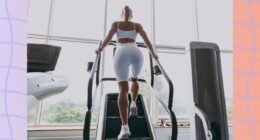
Anyone who spends a lot of time sitting knows how easy it is to end up in a hunched-over position without thinking about it. Incorporating some posture exercises into your fitness routine will help you sit and stand taller in your everyday life, which you’ll want to do to avoid the aches and pains that can come with sitting or standing with poor posture for an extended period of time.
What is good posture?
As SELF has previously reported, posture refers to your body’s alignment at any given moment. There are two types of posture: static posture, which refers to how your body is positioned while sitting, standing, or sleeping; and dynamic posture, which describes your body’s position in motion.
What constitutes “good” posture is a posture that keeps your joints, and soft tissues like muscles and tendons, aligned in a neutral position. Think: a position that feels natural and comfortable and not like you’re stretching or straining or pulling on anything.
Whether you’re seated or standing, your pelvis plays a major role in your posture, Phillip Higgins, D.P.T., a physical therapist who works with older adults at Bespoke Treatments in Seattle, Washington, tells SELF. “Your spine is a column, so if you manipulate one portion, it’s going to impact how the other parts behave,” he explains. “Finding a solid pelvic-neutral position will help the rest of your body.”
To do that while seated, first sit in a chair, feet flat on the floor. Sit up tall and engage your abdominal muscles. (Here’s exactly how to activate your core if you’re not sure.) Tuck your pelvis under a tad, engaging your glutes a little as you do, so that your lower back isn’t arched uncomfortably. You might naturally have a slight arch, and that’s OK as long as it feels comfortable. You want to make sure you’re not putting all your weight into your low back—sitting up and engaging the core will help with that.
Then, focus on your shoulders. “You want a nice relaxed shoulder retraction,” Dr. Higgins says. That means keeping the shoulders relaxed so that your shoulder blades are in place comfortably in the mid-back. That doesn’t mean you need to squeeze them, Dr. Higgins adds, and you should be able to breathe freely.
Once your pelvis and back are in the right position, you should be able to rest your head right on top in a way that feels comfortable, Dr. Higgins says.
“Standing is somewhat similar,” he adds. “Your feet are planted, and you first need to control that pelvis. Don’t lock out the knees—you want a soft knee, controlled pelvis, and a relaxed and retracted spine.”
READ RELATED: NHS waiting list hits ANOTHER high amid Covid-fuelled crisis: 6.18MILLION waiting for routine ops
Why is good posture important?
When you have bad posture, you end up putting extra stress on your joints and muscles. As SELF has previously reported, over time bad posture can lead to widespread body pain, particularly in your neck, back, knees, and hips. Bad posture also can throw off your balance and in some cases, poor body alignment can even cause breathing problems, according to the National Institutes of Health (NIH).
Poor posture can also result in tightness that can limit your ability to do everyday tasks, like reaching behind your back to wash it in the shower, Dr. Higgins says. By maintaining good posture, you’ll ultimately be able to better move.
What makes a good posture exercise?
When it comes to incorporating posture exercises into your fitness routine, Dr. Higgins recommends first focusing on your core strength, which is what gives you good control of your pelvis, and then moving up to exercises that strengthen the upper back.
“If you can’t control the pelvis, the upper back stuff won’t matter,” Dr. Higgins says. “They impact each other.” Also, he adds, people can arch through their lower spines to have “good posture,” or at least what looks like it from the shoulders up. But compromising your lower back for seemingly good posture isn’t doing you any favors.
Easy posture exercises
Dr. Higgins recommends the below exercises for improving posture.
You can string them all together as a posture-focused workout: Do 2 to 3 sets of 12 to 15 reps of each exercise. Doing them in order will help you progress from simple pelvis control work all the way up to back strength work.
You can also choose a few to add to your regular workout if you don’t have time for a full separate workout. The bodyweight-only moves on this list are great additions to any dynamic warm-up or cool-down, too.
Demoing the moves below are Rachel Denis (GIFs 1, 3, and 8), a powerlifter who competes with USA Powerlifting and holds multiple New York State powerlifting records; Cookie Janee (GIF 2), a background investigator and security forces specialist in the Air Force Reserve; Grace Pulliam (GIFs 4 & 6), an aerial yoga and Vinyasa yoga teacher in New York City; Morit Summers (GIF 5), a Brooklyn-based trainer and the owner of body-positive gym, Form Fitness Brooklyn; and Tiana Jones (GIF 7), a dance and fitness instructor based in New York City.
Source: https://www.self.com




